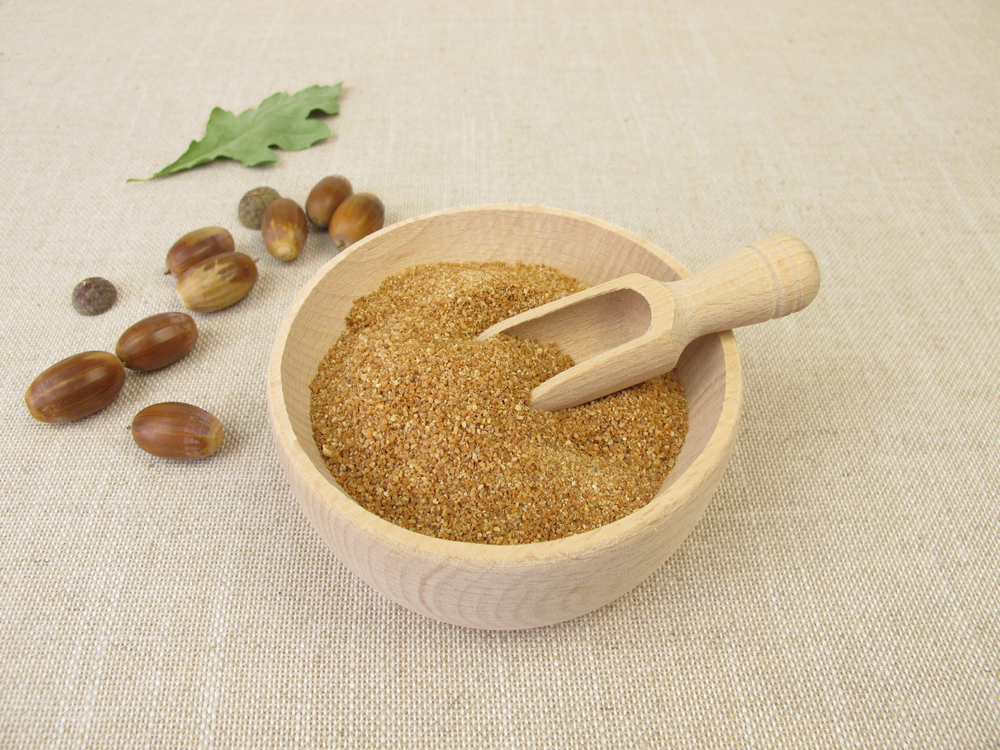A guide to gathering and leaching acorns.

Acorns, once released of their tannins, are remarkably sweet foods.
They’re filled with amazingly high quantities of sugars, fiber, carbohydrates, fat and protein. They have a flavor somewhat reminiscent of chestnuts once processed and their sweetness is very subtle, making them ideal bases. Acorn gel is famous for taking on the flavor of whatever it is cooked with.
GATHERING
Acorns can often be perfectly good straight off the ground, even if wet. So it isn’t always necessary to get up into the branches of a tree to harvest them. They should be undamaged and they should have their caps, but those caps shouldn’t be green. Such spoiled or unripe acorns can be left for wildlife. A simple test to see if an acorn is good is to put it in a bucket of water. If it floats, it’s no good, likely underdeveloped or hollow inside from predation.
A quick fix to remove bugs from acorns is to immediately store them in the freezer. The traditional Indigenous way of sun drying the acorns slowly is a tried and true method of removing insects, as well.
LEACHING
The first step in processing acorns is to get the outer husks off. This means cracking and removing the outer shell with a hammer. Once you’ve got the shell off, soak the nuts to clean off any debris. Dry the acorns and put them in a canvas bag or other breathable bag.
Next, you’ll need to rid them of their tannins which stain them dark and make them bitter. Take the shell-less nuts and pound them roughly, into a powder consistency. Then run water through these pieces. The finer the pieces, the more surface area is exposed to water, thus bringing more tannins in contact with water to be flushed away. There are several ways to go about this.
More traditionally, we scrape out a sand basin and line it with a cloth sack liner. We pour water through it again and again. Or we can achieve a somewhat speedier result by placing the nuts in a plastic garbage bin strapped to the top of our car or wedged in the back seat so as not to tip over. We place the lid tightly onto the bin. Then we drive around with the bin sloshing and agitating the contents while we go about our daily errands. As an afterthought, we end up leaching the tannins out of our acorns.
But my favorite and most used method is to leach the nuts in small batches by bagging them and hanging the bags within the tank behind our ceramic toilet fixtures. We are able to clear several batches in a few days this way.
There is some disagreement among foragers about whether the water used to leach the nuts should involve cold or boiling water. I fall down on the side of the cold since we are trying to preserve flavor, texture and vitamin content of the acorns. Hot water treatments, especially boiling, alter the texture and flavor that we expect from acorns.
So regardless of what method you choose to leach your acorns, you’ll want to make sure to repeat multiple soaks and rinses until the tannin color leaves and the water runs clear through it. Finally, you’ll want to squeeze the water from the acorn mass by wringing the cloth wrapping or bag.
Take the mass of acorn pieces and grind it on a metate or pulse it in a food processor until it reaches a consistency of flour. Let the flour dry and regrind if necessary. Keep it in a jar. It should have a shelf life of up to two years.
Mark Lewis is a forager, member of the Pajaspuypayem tribe and retired economic botany professor at Arizona State University.
My family has been harvesting Gamble acorns for years. The Gamble Oak is a white oak, the acorns are small. The acorn meal is well worth the effort I use directly in turkey stuffing, and in any oat cobbler topping but apple is the best. The flavor is unique but reminiscent of roasted almonds. I use an antique sausage mill to grind the soaked acorn into a meal. At times abundant, sometimes scarce, always leave a fair share of acorns for the elk and squirrels
It depends on the type of oak. Red oaks have tannins but white oak and their huge nuts don’t seem to.
In Korean cuisine, acorn flour is made into a yummy jello-type block. Soy sauce Is drizzled on these soap bar size blocks.
That’s a lot of work to get something to eat. Grow a vegetable garden and you can eat what is fresh and easily preserve a lot of it.